Pros
Cons
Tour & Design
The Denon AH-NC732 headphones are made from black plastic that has a dull luster. The on-ear cups have foam pads covered with soft plastic, can fold up into the band, and can rotate about 135 degrees.

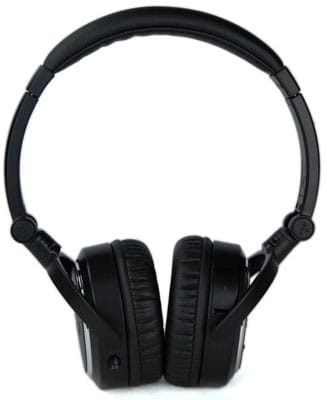

The left, center, and right views of the Denon AH-NC732s.
[

](https://www.reviewed.com/headphones/images/upload/Image/Reviews/Denon/AH-NC732/folded-1000.jpg)
An example of how bendy these things are (click for bigger picture).
The band has a metal core, is extendable, and is also padded.
[

](https://www.reviewed.com/headphones/images/upload/Image/Reviews/Denon/AH-NC732/band-1000.jpg)***Note the length of band extension. This is about average, but should let these things
fit just about any head (click for larger image).***
The left ear cup has a recessed 1/8-inch port for the audio cable. The right ear cup has a battery cavity that seats a single AAA, an on/off switch, and an LED to let you know if the active cancellation feature is engaged.
In the Denon AH-NC732s' box, you will find the following: airplane adapter, 1/4-inch adapter, detatchable cables (2.3 feet and 4.92 feet), a single AAA battery, and a carrying case.
[

](https://www.reviewed.com/headphones/images/upload/Image/Reviews/Denon/AH-NC732/in-box-big.jpg)
***While this is more than lower-end headphones will give you, for headphones
in the AH-NC732s' class this is a standard set of included items.***
Overall, the AH-NC732s seem very durable. They have a good cord guard around their plug, and the plug itself is bent at a 90-degree angle. This design tends to last a bit longer than straight plugs, which can quickly wear down the cables inside the cord.

The AH-NC732s are a small set of on-ears, slightly smaller than the Bose QuietComfort 3s. They have a very reserved aesthetic, but it's clean, simple, and won't embarrass you. While we definitely thought they were nice looking, there isn't any wow factor at all. The only notable aesthetic factor we noticed (other than a general sense of 'these look ok') was that, when worn, the AH-NC732s tend to curve away from the natural curve of the head. A little above your temples, the band will fall away from your head before arcing back to meet the cups. This could look a bit silly at times. Otherwise, however, the Denon AH-NC732 headphones have a nice, professional look, but are a bit too plain to have any real charm.
Performance
About our testing:
Our testing rig consists of hardware and software used by manufacturers. Our hardware is a head and torso simulator, or HATS, which is pretty much what it sounds like it is. It looks like a mannequin from the waste up (minus the arms) and uses high-sensitivity microphones in its anatomically correct ears. Our software is SoundCheck, by Listen, Inc., which is an electroacoustic analysis program that lets us produce and examine soundwaves. For our testing, For more information on our tests, read this article.
**Frequency Response** *(2.28)* [

](https://www.reviewed.com/headphones/content/How-We-Test-149.htm#Frequency_Response)
How the test works:
For this test, we put the headphones on HATS and play back a frequency sweep (100 to 20,000 Hz), where each tone is being played back at a known decibel level. HATS listens to the playback through the headphones and sends back information on what it heard. Soundcheck uses the data to figure out how much emphasis the headphones put on each frequency. The left side of the graph is the decibel level, the bottom axis is the range of tested frequencies, and the dotted lines are the limits. If you'd like more info, click the orange icon above.
What we found:
The Denon AH-NC732's frequency response has some issues towards the higher third of the graph. The bass is emphasized, but not emphasized too much. At around 7kHz, the graph takes a huge plunge. This is the frequency you'd want to equalize up if you like drums, so this dip might take some of the punch out of drum-heavy songs. After that initial downward spike, the graph rescues itself for a very short period of time, only to fall back below the lower limit.
One thing you should look out for on these graphs are sharp lines. That means that an instrument straddling that frequency range can have a dramatically different emphasis for different notes. The sudden dip down around 7kHz and the subsequent zig-zagging means that things toward the higher end might seem a bit inconsistently emphasized.
Again, the AH-NC732s have a fine response for the lower frequencies, but tend to fumble higher ones.
How the Denon AH-NC732 compares:
The average score for this section is presently 4.01, so the Denon AH-NC732s are a bit worse than average. They aren't the worst of the headphones below, but that's not saying much: the QC3s fall off earlier and further.
Looking at the non-QC3 comparison headphones below, it's obvious why the AH-NC732s underperformed. Those that do stray outside the limits go nowhere near as far off their mark as the AH-NC732s (again, with the exception of the QC3s). The 6isolators have a very flat response and only dip slightly outside the limits in a very small area. It's intersting to note that most of the active cancellers (the AH-NC732s, MDR-NC500Ds, and QC3s) follow more or less the same trend of a good bass response but an underemphasized higher end. The exception to this rule is the Creative Aurvana X-Fi, so the previous three headphones can't blame their poor performance on some flaw inherent in active cancellation.

](https://www.reviewed.com/headphones/content/How-We-Test-149.htm#Frequency_Response)
How the test works:
This time we run the same frequency sweep through the headphones, only this time we're measuring any differences between the original soundwave and what HATS ends up hearing from the headphones. Any differences are represented in the graph below as a percentage of distortion present at any given frequency. Anything below 3% is negligable. Again, we play a frequency sweep through the headphones, this time from 100 Hz to 10 kHz. Since the frequency sweep is a known sound wave, we can measure the difference between it and what HATS ends up hearing. This difference is what's known as total harmonic distortion. Lower levels of distortion will only annoy an audiophile, but even a layperson's ear will find anything over 3 percent to be noticeable. In the graph, the left side represents the percentage of distortion, and the bottom of the graph represents the frequency spectrum we tested. If you'd like more info, click the orange 'i' above.
What we found:
The Denon AH-NC732 headphones have virtually no distortion when noise cancellation is turned off. As you can see, the line barely ever raises above zero for the entirety of the frequency spectrum.
When it's turned on, however, it's an entirely different story. That bump in the middle almost reaches 3%, which is almost distracting. If we were to score based on this performance, it would've gotten a 1.16, which would have been the worst distortion score we've assigned by a little over half a point.
Unfortunately, this distortion spike is just something you'll have to deal with if you're listening to an active-canceller. Subpar sound quality comes easily when the headphones are injecting soundwaves into your music that doesn't belong there. What we'd recommend doing is shutting off the noise cancellation when you don't need it. Chances are, if you do, you're in a loud enough environment that the distortion will seem like a natural byproduct of the ambient noise.
Of course, this means the AH-NC732 has the distinction of having both the best and worst distortion scores, if only for now.
How the Denon AH-NC732 compares:
Of course, the AH-NC732, as our current high score topper, blows away the competition. As good as the other headphones here are, they all have more distortion than the AH-NC732s.

](https://www.reviewed.com/headphones/content/How-We-Test-149.htm#Tracking)
How the test works:
To test tracking, we analyze our frequency sweep playback and measure the relative decibel level of each ear cup. The graph below shows any differences in the relative volumes of the left and right channel. If the left channel is playing louder than the right, the line will swing up; if the reverse is true, the line will dip down.
What we found:
The AH-NC732s had a rocky tracking test. It doesn't have any huge swings throughout the main part, but this is a normalize graph and that short downward spike after 1kHz looks like it might've actually plunged down a bit further than this graph shows. Also, towards 10kHz the graph bounds upwards, meaning the volume swings dramatically to the left channel. After that point it gets a bit scribbly, but that's typically what happens on the high end. While there aren't any drastic pulls either way on this graph, it's far from smooth. This being said, even the drastic swings are less than a 10 decibel shift, which isn't particularly noticeable.
How the Denon AH-NC732 compares:
The Denon AH-NC732 has a wobbly tracking graph. Just by eyeballing the tiny little graph thumbnails below it's apparent it didn't do too well. Again, we don't score on the lower or higher end of the graph since the data isn't 100% accurate. The only pair of headphones that are comparably rocky are the Aurvana X-Fi headphones, but even they don't jump to the height that the AH-NC732s do.
**Maximum Usable Volume** *(6.81)* [

](https://www.reviewed.com/headphones/content/How-We-Test-149.htm#Maximum_Usable_Volume)
How the test works:
This test is actually a series of distortion tests. Our distortion test above plays back a frequency sweep at a set decibel level. On this test, we keep bumping the volume up until we reach 3% distortion. This level of distortion would be noticeable and annoying.
What we found:
The Denon AH-NC732s are capable of outputting 106.62 decibels, which isn't great. Most headphones can output 110-120dB, which is what we award maximum points for. Anything louder than that is damaging. Reaching 106dB isn't bad, but it might not be enough for those who like it loud.

](https://www.reviewed.com/headphones/content/How-We-Test-149.htm#Isolation)
How the test works:
For this test, we throw the headphones on HATS, then blast them with pink noise (low frequencies are played louder than high frequencies to keep everything at about the same energy level). HATS listens for the sounds that get through the headphones and their fancy noise cancellation. On the graph below, the blue line is when active cancellation is switched on and the green line is when the active cancellation is switched off.
What we found:***
The main selling point of the AH-NC732s is their active noise cancellation. Denon touts it as capable of cancelling out 99% of external sound, which is a figure vague enough to essentially be meaningless. Interestingly enough, contrary to the norm in such oversteps of marketing, the AH-NC732s aren't bad. In fact, they have decent cancellation for a set of active-cancellers. They're currently our second best set of active-cancellers, after the Creative Aurvana X-Fi headphones.
Like other active-cancellers, the AH-NC732 mainly blocks out bass frequencies, and like other active-cancellers, the cancellation actually creates a bit of noise towards the middle frequencies. Again, this isn't as good as a good set of in-ears, such as the Etymotic Research 6isolators, but they represent the current upper crust of active cancellation.
How the Denon AH-NC732 compares:
For the majority of those reading this review, this section is the most important one. Exactly how well does the AH-NC732s' noise cancellation do, compared to other competitors - or, for that matter, how well does active noise cancellation even work to begin with? If you find yourself asking that question, then we certainly have an exciting array of graphs for you. Again, the blue lines are active cancellation, green lines are passive. No blue line means no active cancellation.
First of all, good ol' earplugs seem to beat noise cancellation in terms of overall isolation, as evidenced by the 6isolators. If you're looking for some spot reduction on bass, however, then active cancellation is something to look into. In this regard, the AH-NC732 headphones score between the QuietComfort 2 and 3. The QuietComfort 2s form a poor seal with the head (the padding is fuzzy and about as air-tight as a stuffed bear) so we weren't surprised to see the AH-NC732s win that match-up. It's very similar to the QC3s in terms of forming a tight seal with your head (both headphones use similar material on their pads), but the QC3s block out a bit more bass.
While the AH-NC732s and their noise cancellation aren't the worst out of the headphones we've reviewed, they aren't as good as the Bose QuietComfort 3 headphones, and both underperform versus a pair of in-ear headphones.

](https://www.reviewed.com/headphones/content/How-We-Test-149.htm#Isolation)
How the test works:
To test leakage, we put a microphone a set distance away from our headphone-outfitted HATS and then play pink noise through the headphones. The microphone then reports everything it hears back to SoundCheck.
What we found:
The AH-NC732 aren't the quietest headphones ever - on the contrary, they actually leak a bit more that you'd think, given their cancellation abilities. This being said, the AH-NC732 has the second-highest score in this category for a non-in-ear headphone (the Sony MDR-DS6000 currently occupies first place). This achievement doesn't say all that much for the AH-NC732, but it also doesn't say much for non-in-ear headphones in general. If you like listening to your music really loud, someone sitting next to you will probably hear it. If you're in a library or quiet office, everyone will glower at you.
In Use
In order to test comfort, we unfortunately have to default to our own. While this is great news for anyone with our exact head specifications, for others this section will serve as a mere guide. Please, harass the store to let you try on headphones before purchasing. Uncomfortable headphones are only slightly better than broken headphones.
If nothing else, the Denon AH-NC732 headphones are comfortable. They don't grip the head too tightly, but they also don't shake around. The pads have a soft covering, and gently rest against the sides and top of your head (since the band is thoughtfully padded as well). While the headphones are a bit bulky, they never feel heavy. The buttons are easy to reach, although they could have more diverse shapes to aid in finding them by touch.
We took the headphones for a jog, and they tended to stay put while we moved, although we wouldn't recommend getting all sweaty with these headphones: there's just a thin cloth between your ears and the sound element.
The only caveat we have is for those who aren't used to noise cancellation: chances are it'll make your head feel funny for the first few hours. We've heard it described as feeling like one's head was under water, like the person was adrift in space, like the person had to pop their ears, etc. We recommend wearing the headphones for at least a few hours to get used to the sensation before making any judgments in regards to comfort.
After a wear session of six hours, we felt exactly the same. The pressure didn't seem to grow with time, in fact, as we got used to them the pressure actually seemed to lessen slightly. Conversely, wearing these headphones can make your ears a bit hot since they're basically ear muffs with a good seal. Overall, however, the AH-NC732 headphones are very comfortable, even during extended use.
**Cable Connectivity***(7.49)*
The main cable for the AH-NC732 headphones is 59 inches long, aka 4 foot, 11 inches, aka 1.5 meters. The secondary cord is a great deal shorter, only measuring 2 foot, 2.75 inches (0.68 meters). There isn't an inluded male-to-male 1/8-inch plug connector, so you unfortunately can't join your cables together unless you can provide such an adapter.
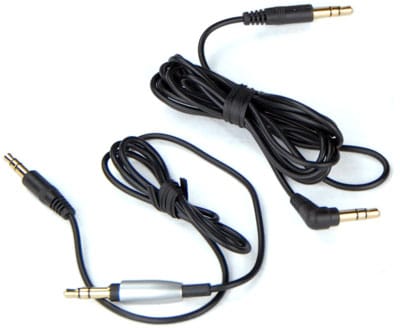
***These are the two cords that come in the box. It would've been nice to have a male-to-male
connecter to form one long cord, but alas, we do not live in such a world. ***
The short cord is great for commuters, but the long cord isn't all that long. Again, If there were some included adapter that would let you hook the two cables together, it would certainly help out.
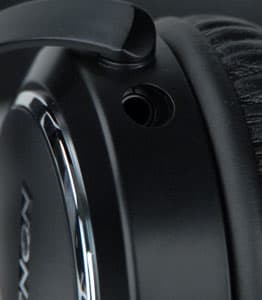
This is where you'll insert the audio cable of your choice.
The AH-NC732 package also comes with two adapters: 1/4-inch and airplane (double prong). Chances are the 1/4-inch adapter will get used a lot more than the airplane adapter, but it's still nice to see both included.
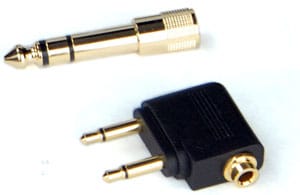
These two adapters are standard pack-ins.
These headphones aren't the most portable headphones out there, but they aren't the least portable either. Over-headphones are large by design. It's not like you can just shove the AH-NC732 into your pocket when you're done listening.
The AH-NC732s come with a case that, strangely enough, doesn't look like the Bose case. That makes teh AH-NC732s the first active-cancellers to not take their emulation of the QuietComfort series to shameful depths.
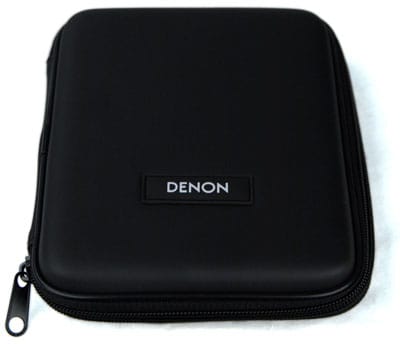
The closed case.
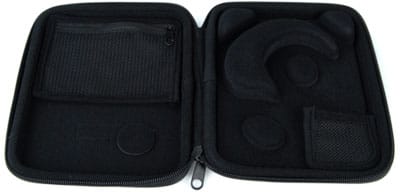
***This is what the case looks like empty. Those pouches are velcro'd on,
so feel free to move them around.***
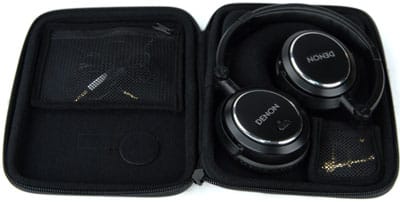
**This is the case with everything shoved inside. **
Although everything can be safely and neatly tucked into this case, the case itself isn't particularly portable. Regardless, should you be going on a trip, the case will definitely let you keep your headphones and accessories organized. If you're looking to commute, then leave the case at home and fit the shorter cord onto your Denons.
There aren't any real customization options included in the packaging. You can tilt the ear cups and swivel them all around, and the band extends slightly. There is also the short/long cord option (2 feet, 2.75 inches and 4 feet, 11 inches) to placate commuters and home users alike (although home users might find the sub-five-foot cord a bit short). There aren't any extra cup pads, or faceplates, or even a little rhinestone gun for customizing your headphones further. If you want to customize your AH-NC732s, you'll have to do it on your own dime.
The AH-NC732s are a bit annoying to disassemble. The first step is easy enough, though: remove the padding. The back of the padding has plastic catches that connect it to the cup, which can be seen naked below.
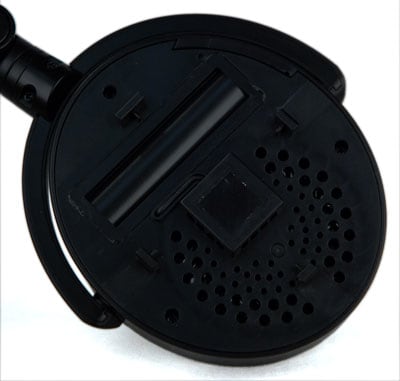
This is what the cup looks like without its padding.
At this point, you'll need a teeny-tiny screwdriver if you want to continue. Unfortunately, we didn't have a screwdriver that small. We're guessing that the average consumer probably won't either, which is unfortunate.
**Other Features***(5.44)*
Battery Dependency
These headphones will eat one AAA battery at a time to keep their active noise cancelling going. The AH-NC732s aren't, however, battery dependent, becausee they will play back music even when the battery is dead. Since many popular active noise-cancellers out there have established a bad trend of not playing when the battery is dead (Bose, go to your room), it's refreshing to see a few companies are still paying attention to user experience.
One thing to keep in mind though: the packaged-in battery is bad. We were only able to get 7 hours, 37 minutes out of the AAA that came with the headphones, which is significantly less than the manufacturer's stated time of 40 hours. We put in the name-brand, store bought battery we typically use for testing, and were able to get 23 hours, 14 minutes, which is better.
Active Noise Cancellation
The AH-NC732's noise cancellation feature is about average in terms of its usability, meaning you can switch it on/off but it doesn't have any additional features.
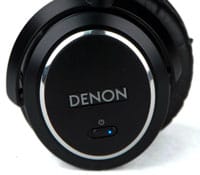
***The on/off switch, although simple, is strangely
absent from many active-cancellers.***
Value & Comparisons
[

If you're looking for a solid, comfortable pair of noise-cancelling headphones, the Denon AH-NC732 headphones are a good choice. They are a bit expensive for their $300 price tag, but out of all the active-cancellers we've reviewed, these offer the most for their purchase price. If you're planning on getting a pair of Bose QuietComforts, then you should strongly consider these headphones as well. They're slightly noisier when the active noise cancellation is activated, but they have the options to turn it off for insanely low distortion.

[

Sony MDR-NC500D](https://www.reviewed.com/headphones/content/Sony-MDR-NC500D-Headphones-Review-471.htm) - This match-up is pretty straight forward. The Denon AH-NC732 headphones are $100 cheaper and have better isolation and distortion. The Sony MDR-NC500D performs slightly better in some areas, like frequency response and tracking, but they weren't so amazing to make up the price difference. The only situation we'd recommend you go with the MDR-NC500Ds is if you like its sound better and aren't worried about sticking to a budget.
[

](https://www.reviewed.com/headphones/content/Bost-QuietComfort3-Headphones-Review.htm)
Bose QuietComfort 3 - The Bose QC3s are active noise cancellation celebrities. While they offer very similar audio quality and about the same user experience, they cost $50 more. The Denon AH-NC732 headphones are a slightly better deal and have the option of turning their active cancellation off. We recommend the AH-NC732s, but if you're considering either of these headphones, you should give a listen to the other.
[

](https://www.reviewed.com/headphones/content/Creative-Aurvana-X-Fi-Headphones-Review-496.htm)
Creative Aurvana X-Fi - The Aurvana X-Fi has some neat active cancellation features, but are average elsewhere. The X-Fis actually out-performed the AH-NC732s on audio quality by a little bit, with the noted exception of distortion. They have the same price as well, but feel a lot cheaper in hand. This match-up is really user-dependent since the headphones are so similar: would you rather have very low distortion or non-noticeably better overall audio quality and some active noise cancellation features? One other thing to keep in mind is how the things look on you; both the AH-NC732s and the X-Fis have slightly weird shapes.
[

](https://www.reviewed.com/headphones/content/Grado-SR60-Headphones-Review-235.htm)
Grado SR60 - The Grado SR60s are made for an ideal listening environment while the AH-NC732s are made for just about any listening environment. The SR60s also have far worse audio quality than the AH-NC732s and aren't as comfortable. There's only one category where the AH-NC732s don't have the SR60s beat, and that's in price. If you're a budget shopper or looking for the better pair of headphones, your choice is clear. If you're looking for a good value, it's honestly a toss up. In this case, listening is really important, if only to get a feel for the headphones. We can see how some people might think the SR60s aren't particularly comfortable.
[

Etymotic Research 6isolator](https://www.reviewed.com/headphones/content/Etymotic-6isolator-Headphones-Review.htm) - The ER 6is prove that a good old fashioned plug is still better than today's fancy-pants technology. These things have better overall audio quality, isolate better, and are more portable. The AH-NC732s have much better distortion control, but that's really their only selling point (other than staying out of your ear canal). The 6is are also cheaper. We'd tend to recommend the 6is, but they're not so much better than you shouldn't give the AH-NC732s a shot.
Conclusion
Conclusion

The Denon AH-NC732 headphones are a step in the right direction. They're still a bit expensive, and their audio quality overall isn't the best, but they do have a few strong points. Their cancellation, although still inferior to a set of analog ear plugs, is some of the best we've seen (although that '99% noise cancellation' selling point is essentially meaningless). They also have very low distortion when the active noise cancellation is turned off — and simply being able to turn off active cancellation is great in and of itself.
The real strength of the AH-NC732s, like the Bose QuietComfort series, is their versatility. They are portable for a set of non-in-ears and have decent isolation, which means they're fine on the go. You can also switch off the cancellation for some distortion free playback at your home. Assuming you're looking for active cancellers in this range and think they look good on you, the AH-NC732s are a good pick.

While audiophiles will be impressed with the data behind the AH-NC732s' distortion score, these headphones have far from perfect audio quality. This being said, these are the best headphones we've reviewed to date with active noise cancelling (partially because you can turn it off).
We're unsure how to call this one. No, they're not as portable as in-ears. They are, however, a lot more portable than other on-ear or over-ear headphones due to their foldability and secondary, shorter cord. The active cancellation is also nice for keeping the sounds of your commute out of your music. If you don't like in-ears, then the Denon AH-NC732s get a big thumbs up from us. If you could go either way, we'd probably recommend the Sennheiser MM 50 iP headphones since they're a bit more portable and have a microphone button, which will help you skip from song to song provided your media player supports this feature.
Airplane travelers should like these headphones. They block out a good amount of noise, could let you fly around the globe with only two AAAs to support the noise cancellation, and are more portable than the average non-in-ear.
The AH-NC732s don't have a particularly long cord, which might make hooking up to your stereo a problem. Also, although they have a very low distortion score, overall their audio quality isn't that great. They have a closed back, which would normally rule out an open soundstage, but the active cancellation feature means they're basically semi-open. Still, the AH-NC732s don't even really benefit from their closed backs, and leak enough sound to preclude them as an o when someone else needs quiet. We think you should consider them if you're looking for versatility, but if you're looking for a straight-up pair of in-home cans, there are better options out there for you.
Meet the tester
Mark Brezinski works on the Home Team, reviewing refrigerators, minifridges, dishwashers, washing machines, dryers, air conditioners, air purifiers, and fans.
Checking our work.
Our team is here to help you buy the best stuff and love what you own. Our writers, editors, and experts obsess over the products we cover to make sure you're confident and satisfied. Have a different opinion about something we recommend? Email us and we'll compare notes.
Shoot us an email